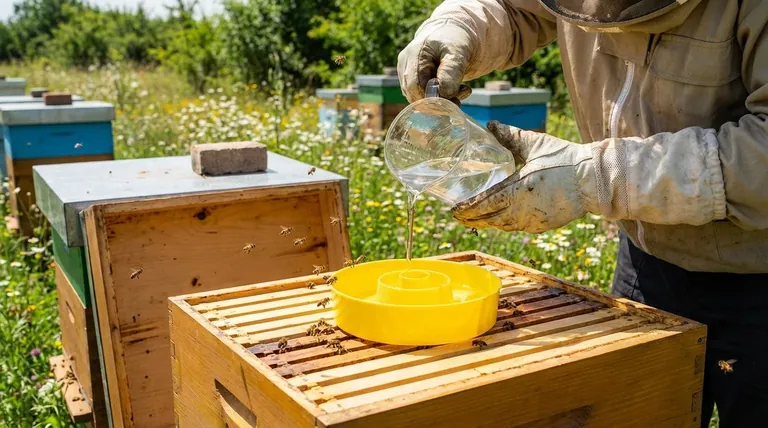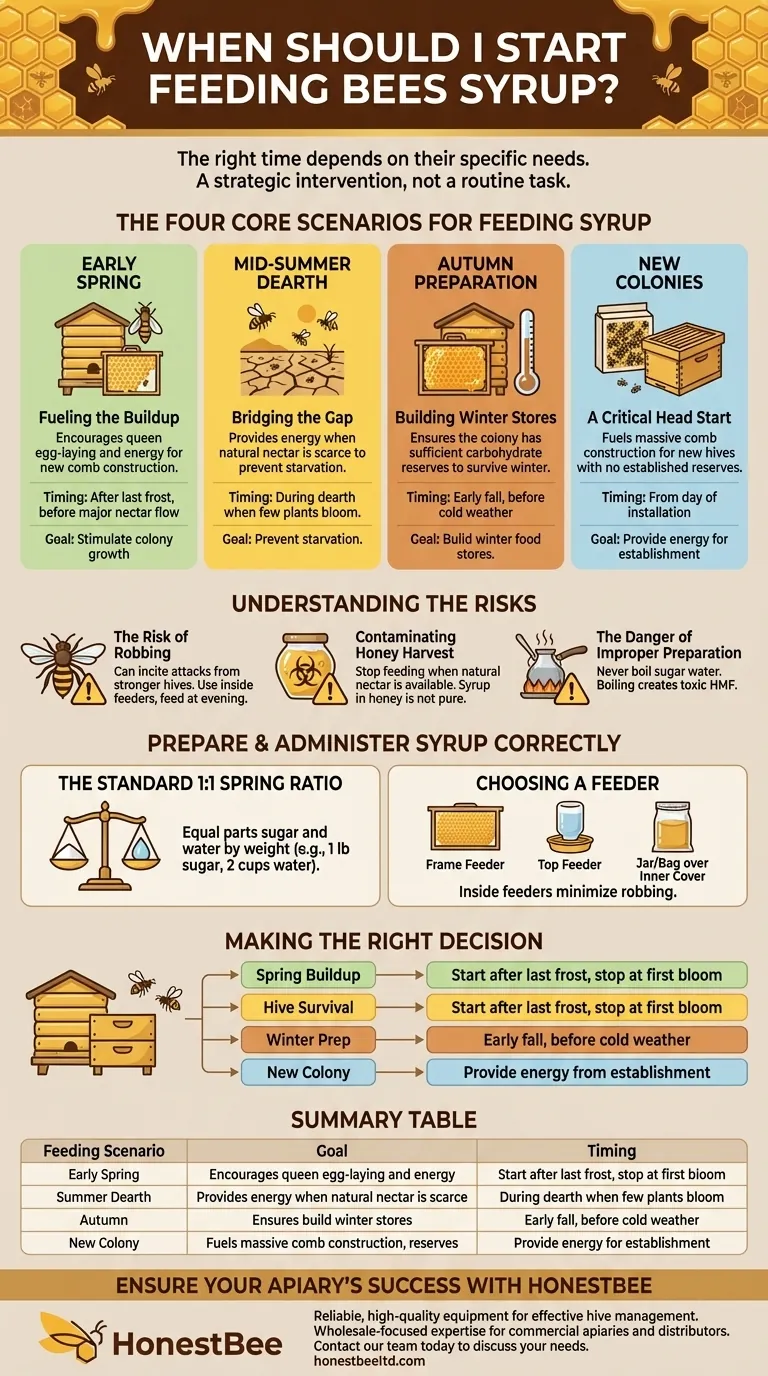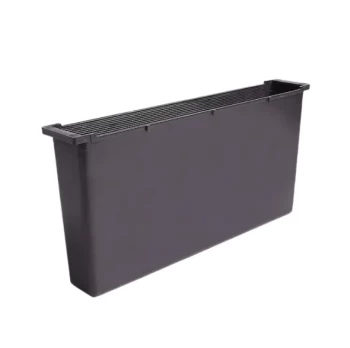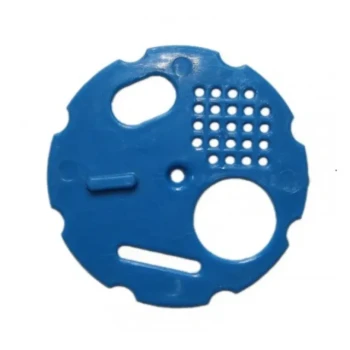The right time to feed bees syrup depends entirely on their specific needs. You should feed bees in early spring to stimulate colony growth, during a summer nectar dearth to prevent starvation, in the autumn to ensure adequate winter stores, or any time you are establishing a new colony.
Feeding sugar syrup is not a routine task but a strategic intervention. Your goal is to supplement natural forage only when necessary to help the colony survive or achieve a specific objective, like building comb or preparing for winter.

The Four Core Scenarios for Feeding Syrup
Understanding why you are feeding is the most critical part of the process. Each scenario has a distinct goal that dictates your timing and approach.
Early Spring: Fueling the Buildup
In early spring, feeding a light syrup encourages the queen to start laying eggs and gives the growing workforce the energy they need to build new comb.
This "stimulative" feeding provides resources before the first major nectar flows begin, giving the colony a head start for the season.
Mid-Summer Dearth: Bridging the Gap
A "dearth" is a period during the summer when few nectar-producing plants are in bloom, often due to high heat and lack of rain.
During a dearth, a strong colony can quickly consume its stores. Supplemental feeding provides the necessary energy to prevent starvation and maintain the colony's population.
Autumn Preparation: Building Winter Stores
As fall approaches, you must ensure the colony has enough stored food to survive the winter. If their honey stores are insufficient, you need to feed them.
The goal of autumn feeding is for the bees to store the syrup, not consume it immediately. This ensures they have the carbohydrate reserves needed to generate heat and survive the cold months.
Establishing New Colonies: A Critical Head Start
Newly created nucleus hives (nucs) or packages of bees have no established food reserves. They are entirely dependent on the beekeeper.
Feeding is essential from day one to fuel the massive amount of comb construction required to house the queen, brood, and incoming resources.
Understanding the Trade-offs and Risks
Improper feeding can do more harm than good. A responsible beekeeper must be aware of the potential dangers.
The Risk of Robbing
Feeding can incite "robbing," where bees from stronger nearby hives attack a weaker hive to steal its food stores.
To minimize this risk, always place feeders inside the hive and feed towards the evening, when bee activity is lower. This reduces the scent of syrup that might attract robbers.
Contaminating the Honey Harvest
You must stop feeding syrup as soon as natural nectar becomes widely available. This is a critical rule for anyone who plans to harvest honey.
If you feed during a nectar flow, the bees will store sugar syrup in the honeycombs. This contaminates the final product, meaning it can no longer be legally and ethically sold as pure honey.
The Danger of Improper Preparation
Never boil the sugar and water mixture. Boiling can create Hydroxymethylfurfural (HMF), a compound that is toxic to bees.
The correct method is to pour near-boiling water over the sugar and stir until it is completely dissolved. The final syrup should be clear and cooled to room temperature before being given to the bees.
How to Prepare and Administer Syrup Correctly
The mechanics of feeding are simple but must be done with care to protect your bees and your honey.
The Standard 1:1 Spring Ratio
For spring feeding and supporting new colonies, a 1:1 syrup is standard.
This is made by mixing equal parts sugar and water by weight, such as 1 pound of sugar to 1 pound (2 cups) of water.
Choosing a Feeder
Several types of feeders are effective, each placed inside the hive to prevent robbing.
Common options include frame feeders that replace a frame in the hive box, top feeders that sit on top of the frames, or simple jars and bags placed over the inner cover.
Making the Right Decision for Your Hive
Your timing should always be dictated by the hive's specific condition and your management goals.
- If your primary focus is spring buildup: Begin feeding after the last frost, when bees are flying, but stop as soon as you see them bringing in natural nectar from the first major bloom.
- If your primary focus is hive survival during a dearth: Start feeding immediately when you observe a lack of incoming nectar and pollen, and continue until the next nectar flow begins.
- If your primary focus is winter preparation: Begin feeding in early autumn to give the bees plenty of time to process and store the syrup before cold weather prevents them from breaking cluster.
- If your primary focus is establishing a new colony: Feed continuously from the day of installation until the bees have drawn out all the comb in their first hive box.
Ultimately, feeding is a powerful tool to ensure your bees don't just survive, but thrive.
Summary Table:
| Feeding Scenario | Goal | Timing |
|---|---|---|
| Early Spring | Stimulate colony growth & brood production | After last frost, before major nectar flow |
| Summer Dearth | Prevent starvation during nectar shortage | When natural forage is scarce |
| Autumn | Build sufficient winter food stores | Early fall, before cold weather sets in |
| New Colony | Provide energy for comb building & establishment | From day of installation until first box is drawn out |
Ensure your apiary's success with the right supplies from HONESTBEE.
Feeding your bees correctly is crucial, and having reliable, high-quality equipment makes all the difference. Whether you are a commercial apiary managing hundreds of hives or a distributor supplying beekeepers, HONESTBEE provides the durable feeders, smokers, and essential gear you need for effective hive management.
Let us support your operation with our wholesale-focused expertise and premium beekeeping supplies. Contact our team today to discuss your needs and keep your colonies thriving.
Visual Guide

Related Products
- HONESTBEE Round Hive Top Bee Feeder for Syrup
- Rapid Bee Feeder White Plastic 2L Round Top Feeder for 8 or 10-Frame Bee Hives
- Classic Boardman Entrance Bee Feeder Hive Front Feeding Solution
- HONESTBEE Entrance Bee Feeder Professional Hive Nutrition Solution for Beekeeping
- Boardman Entrance Bee Feeder Durable Galvanized Steel and Wood Construction for Beekeeping
People Also Ask
- How should syrup for bees be prepared? Master the Ratio for a Thriving Hive
- How do hive top feeders work? A Guide to Efficient, High-Capacity Bee Feeding
- What safety features are included in top feeders? A Guide to Drowning Prevention and Hive Safety
- What is the correct method for preparing sugar syrup for bees? Ensure Safe, Non-Toxic Feeding for Your Hives
- What types of hive boxes is the round hive top feeder compatible with? Universal Fit for 8 & 10-Frame Langstroth Hives



















